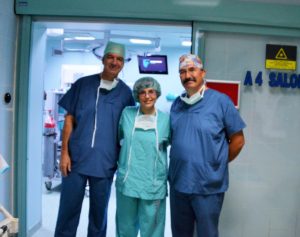
Dr. Isik
Is there five year survival for patients with malignant pleural mesothelioma (MPM)? This is just one of the many questions we asked during an interview with one of the surgeons in the APN network as part of a series discussing HITHOC (hyperthermic intra-thoracic chemotherapy) for malignant pleural mesothelioma and other cancers.
Today, Dr. Isik, a thoracic surgeon, with extensive experience with mesothelioma and HITHOC talks with APN. We are discussing malignant pleural mesothelioma, the HITHOC procedure and the latest research findings in a Questions and Answers session.
WARNING: This video contains graphic surgical images.
Full Transcript from video is below.
Q. Would you please talk about your academic career briefly?
Dr. Isik: I graduated from University of Ankara, Medical School in 1991 and attended to residency in thoracic surgery of same institute. After getting to be Thoracic Surgeon in 1996, for 23 years I studied mostly on oncology especially lung, pleura and esophageal carcinoma. I have been working as consultant professor since 2013 in University of Gaziantep, Medical school, Thoracic Surgery Department. I am the chief in this department.
For pleural cancers, I have been studying on radical surgery plus hyperthermic intrapleural perfusion chemotherapy (HITHOC) since 2009. Especially in malignant pleural mesothelioma, pleurectomy/decortication and HITHOC intervention has been observed as feasible and improving survival for those patients. Also in stage 4 M1a lung cancer cases, oncological surgery including lung resection and pleurectomy plus HITHOC has improved life comfort and survival.
I established the Advanced Respiratory Biology Department in Medical Sciences Institute of University of Gaziantep in 2018 after took over the Basic Respiratory Biology program and cell culture laboratory in September 2016. Postgraduate program about cancers of respiratory organs has begun at September 2018. Since 2015, I have been proceeding the accreditation program of Medical School of University of Gaziantep as coordinator in self-evaluation committee.
I have been working on artificial respiratory center for patients with respiratory insufficiency and have patent on this subject named “Telemetric Diaphragm pacing with feedback”. I completed 7 projects about different subjects including experimental studies on animals and cell culture and infrastructure of medical school and its hospital. I have been member of Toraks, TUSAD, Turkish Thoracic Surgery Association, European Society of Thoracic Surgeons, European Respiratory Society.
Now that we know a little more about Dr. Isik, let’s talk more about HITHOC. After all, that’s why most of our readers are here.
Q. Would you please describe us what HITHOC treatment is?
Dr. Isik: Hyperthermic intrapleural chemotherapy (HITHOC) is an adjuvant intervention just after the radical surgery of pleura and lung if needed. [ During surgery, warmed up chemotherapy medications are applied directly to the tissue of the chest. This is believed to kill any cancerous cells that are too small to be seen directly, so that no cancer is left behind].
In scientific investigations, it was found that hyperthermia leads apoptosis of cells. Apoptosis is one of the pathway of cell death. Cancer cells are immortal if they find suitable habitat in human body. Because of this, microscopic pleural seeding should be eradicated by another procedure after surgery. Heated intrapleural chemotherapy is an applicable and effective treatment used for this purpose. It is administrated just after surgery through pleural drainage catheters under general anaesthesia.

In the operating room
Q. What are the advantages of HITHOC treatment?
Dr. Isik: Chemotherapeutic agents are toxic for human body and cells. For this reason, they cannot be given in high dosages in systemic applications. Hyperthermic intrapleural chemotherapy is a local intervention just after the surgery. So it possible to apply higher dosages of chemotherapeutic agents than systemic therapy, [directly to the affected tissue]. This is the advantage of the treatment. Despite these higher dosages than systemic therapy, we see lesser renal and cardiac complications.
Q.What are the major complications of HITHOC treatment?
Dr. Isik: The major complication of HITHOC treatment is renal dysfunction and insufficiency. However, incidence of these entities is not high. Generally, we observe temporary renal dysfunction. It improves by hydration easily. Severe renal insufficiency is so rare, but it can be healed by renal dialysis. The incidences are 7% and 1% respectively for renal dysfunction and insufficiency in our series.
Q. What is the success rate of this treatment?
Dr. Isik: In literature, the success rate is qualified according to survival rates. It has been observed that patients with pleural carcinoma have better survival with radical surgery plus HITHOC than the others significantly (Mean survival 27-35 months with HITHOC and 6-9 months without, respectively). These patients have the chance of 5 year survival and cure.
Q. Are there any scientific research or evidence for HITHOC? What are the results of those studies?
Both malignant mesothelioma and other secondary pleural cancers have been studied for better survival. As a primary cancer of pleura Malignant Mesothelioma is the most studied subject. Recently, approximately for 15 years most of thoracic surgeons gave up extra pleural pneumonectomy (EPP) because of its morbidity and mortality despite poor prognosis. Radical pleurectomy and decortication with hyperthermic perfusion chemotherapy have been performed instead of EPP. We observed that better comfort and better survival were obtained such as 32-55 months mean survival and 20-25 % five year survival.
Hyperthermic perfusion chemotherapy of pleural space give us a chance for radical solutions of other pleural cancers. Lung cancer is the most seen cancer metastasis pleura. Pleural seeding or metastasis gets the stage to 4 with M1a disease. If patient has no other distant metastasis, we can perform radical surgery for lung cancer plus pleurectomy/decortication and hyperthermic perfusion chemotherapy.
There are many scientific researches about hyperthermic intracavitary chemotherapy for both mesothelioma and other secondary pleural cancers such as lung cancer, breast and over cancers etc.. [Ed. Note. For ease of reading, these references have been placed at the end of the interview].

Dr. Elbeyli and Dr. Isik (right) with APN staff (middle)
Q. What are the expected survival rates for patients who undergo HITHOC treatment?
Dr. Isik: According to literature, radical pleurectomy and adjuvant HITHOC have 28-57 months mean survival. And also have more comfort after surgery and during the treatment period because of lacking pleural effusion recurrence. Five year survival rates are 20-35% for malignant pleural mesothelioma. However we perform radical surgery in patients with M1a lung cancer (Pleural metastatic lung cancer) and other secondary pleural cancers due to such as breast cancer, colon cancer over carcinoma etc. also. In M1a lung cancer cases, we obtain 20-25% 5 year survival where as 6-9 months in patients non-surgery groups. This is significant difference.
Q. Who is eligible for HITHOC treatment?
Dr. Isik: HITHOC after radical surgery for pleural cancers can be performed in patients that have suitable baseline health and limited disease in the hemithorax. Patients need to be strong enough for surgery and have the types of cancers that respond to this treatment.
HITHOC has been used to treat: Pleural cancers including malignant pleural mesothelioma, M1a Lung cancer with pleural seeding or metastases, and other metastatic pleural cancers like breast, colon over etc carcinomas.
Q. How do you know if patient’s are well enough for surgery?
Dr. Isik: We evaluate their medical condition/ baseline health with detailed cardiac and respiratory examinations. Patients need respiratory function tests includes spirometry, to be able to walk 600 meters and climbing 4 flights of stairs. Electrocardiogram and echocardiography if needed are performed by cardiology specialists to understand if patients have any cardiac problem.
Scientific literature and research related to HITHOC:
- Giovanella BC, Morgan AC, Stehlin JS, Williams LJ. Selective lethal effect of supranormal temperatures on mouse sarcoma cells. Cancer Res 1973;33: 2568-2578.
- Giovanella BC, Stehlin JS, Shepard RC, Williams LJ. Hyperthermic treatment of human tumors heterotransplanted in nude mice. Cancer Res 1979;39: 2236-2241.
- Işık AF, Sanlı M, Yılmaz M, Meteroğlu F, Dikensoy O, Sevinç A, Camcı C, Tunçözgür B, Elbeyli L. Intrapleural hyperthermic perfusion chemotherapy in subjects with metastatic pleural malignancies. Respir Med 2013;107: 762-767.
- LangLazdunski L, Bille A, Papa S, Marshall S, Lal R, Galeone C, Landau D, Steele J, Spicer J. Pleurectomy/decortication, hyperthermic pleural lavage with povidoneiodine, prophylactic radiotherapy, and systemic chemotherapy in patients with malignant pleural mesothelioma: a 10 year experience. J Thorac Cardiovasc Surg 2015;149: 558-565; discussion 565-556.
- Li Q, Sun W, Yuan D, Lv T, Yin J, Cao E, Xiao X, Song Y. Efficacy and safety of recombinant human tumor necrosis factor application for the treatment of malignant pleural effusion caused by lung cancer. Thorac Cancer 2016;7: 136-139.
- Lombardi G, Nicoletto MO, Gusella M, Fiduccia P, Dalla Palma M, Zuin A, Fiore D, Donach M, Zagonel V. Intrapleural paclitaxel for malignant pleural effusion from ovarian and breast cancer: a phase II study with pharmacokinetic analysis. Cancer Chemother Pharmacol 2012;69: 781-787.
- Migliore M, Calvo D, Criscione A, Viola C, Privitera G, Spatola C, Parra HS, Palmucci S, Ciancio N, Caltabiano R, Di Maria G. Cytoreductive surgery and hyperthermic intrapleural chemotherapy for malignant pleural diseases: preliminary experience. Future Oncol 2015;11: 47-52.
- Mujoomdar AA, Sugarbaker DJ. Hyperthermic chemoperfusion for the treatment of malignant pleural mesothelioma. Semin Thorac Cardiovasc Surg 2008;20: 298- 304.
- Richards WG, Zellos L, Bueno R, Jaklitsch MT, Jänne PA, Chirieac LR, Yeap BY, Dekkers RJ, Hartigan PM, Capalbo L, Sugarbaker DJ. Phase I to II study of pleurectomy/decortication and intraoperative intracavitary hyperthermic cisplatin lavage for mesothelioma. J Clin Oncol 2006;24: 1561-1567.
- Işık AF, Şanlı M, Dikensoy Ö, Aytekin İ, Benli Y, Sevinç A, Camcı C, Tunçözgür B, Elbeyli L. Can hyperthermic intrathoracic perfusion chemotherapy added to lung sparing surgery be the solution for malignant pleural mesothelioma? Turk Gogus Kalp Dama 2016;24:325-332
- Ried M, Potzger T, Braune N, Neu R, Zausig Y, Schalke B, Diez C, Hofmann HS. Cytoreductive surgery and hyperthermic intrathoracic chemotherapy perfusion for malignant pleural tumours: perioperative management and clinical experience. Eur J Cardiothorac Surg 2013;43: 801-807.
- Sugarbaker DJ, Gill RR, Yeap BY, Wolf AS, DaSilva MC, Baldini EH, Bueno R, Richards WG. Hyperthermic intraoperative pleural cisplatin chemotherapy extends interval to recurrence and survival among low risk patients with malignant pleural mesothelioma undergoing surgical macroscopic complete resection. J Thorac Cardiovasc Surg 2013;145: 955-963.
- Tilleman TR, Richards WG, Zellos L, Johnson BE, Jaklitsch MT, Mueller J, Yeap BY, Mujoomdar AA, Ducko CT, Bueno R, Sugarbaker DJ. Extrapleural pneumonectomy followed by intracavitary intraoperative hyperthermic cisplatin with pharmacologic cytoprotection for treatment of malignant pleural mesothelioma: a phase II prospective study. J Thorac Cardiovasc Surg 2009;138: 405-411.
- Zellos L, Richards WG, Capalbo L, Jaklitsch MT, Chirieac LR, Johnson BE, Bueno R, Sugarbaker DJ. A phase I study of extrapleural pneumonectomy and intracavitary intraoperative hyperthermic cisplatin with amifostine cytoprotection for malignant pleural mesothelioma. J Thorac Cardiovasc Surg 2009;137: 453-458.
- Zhou H, Wu W, Tang X, Zhou J, Shen H. Effect of hyperthermic intrathoracic chemotherapy (HITHOC) on the malignant pleural effusion. Medicine 2017; 96: 1
All photos were taken during a site visit.
